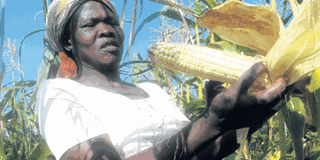Tips that turned my farm into breadbasket

Benter Okeyo checks maize in her farm in Nyakach. PHOTO | LEOPOLD OBI
What you need to know:
- Benter has been planting maize, beans and sorghum in keeping with the traditional farming practices in the region. This time round, she planted the same crops but did things differently.
- Prof James Muthomi, a crop protection specialist at the University of Nairobi’s Department of Plant Science, says some stubborn weeds like the striga, popularly known as the witch weed, can only be curbed by use of manure and better farming practices.
Spaced in 60 by 30cm rows, the sorghum plants stand at five-feet tall, awaiting the harvester’s knife. Benter Okeyo, the owner of the sorghum plantation, in Apoko, Upper Nyakach, is ecstatic.
Her excitement is understandable since for the first time in many years, she will have a bumper harvest.
A few metres from her quarter-acre sorghum farm, there is another half-acre farm with a healthy maize crop. Again, it has been eight seasons since Benter’s maize crop performed this well.
Benter has been planting maize, beans and sorghum in keeping with the traditional farming practices in the region. This time round, she planted the same crops but did things differently.
So what has brought the difference?
The farmer, who is a member of Bidii Table Banking Group, which has 50 members, thanks an agricultural extension officer.
During one of their meetings last year, the field officer from a local NGO paid them a surprise visit.
The officer informed them that for better harvest, they have to engage in good farming practices, beginning with land and manure preparation.
LOSS OF NUTRIENTS
The officer, George Ochieng, says readying for planting should start with preparing compost manure.
“Farmers should dig a composed pit, where they dump all the animal or farm yard manure. It is this manure that comes in handy when planting.”
According to him, this type of manure improves the structure and water-holding capacity of the soil.
“Composted manure also controls parasitic nematodes and fungi by altering the balance in micro-organisms in the soil.”
“Partially composted farmyard manure has to be applied three to four weeks before sowing while well-prepared manure, which takes three months in the pit, can be applied immediately before sowing,” he adds.
Ochieng warns against leaving manure in small heaps scattered in the farm for a long time, as many farmers do after harvesting, since this leads to loss of nutrients.
“Land should be ploughed three times before planting,” he advises. “The first ploughing should be done about eight weeks after harvesting to enable soil to regain its structure. The second ploughing is called furrowing, and this is done at the onset of rains. Compost manure is applied at this stage.
The third ploughing comes three weeks after the second.”
According to the agricultural officer, many smallholder farmers use manure and fertiliser incorrectly.
“Some apply on top of the seeds, in the case of maize or beans, instead of mixing with the soil first before placing the seeds.” He further advises that farmers should embrace crop rotation and diversity.
Armed with the knowledge, Benter and other members of Bidii divided themselves into groups of 10.
“Each person tilled their land, but during planting, group members helped. We planted in April on each other’s farms in turns to save costs.”
Benter expects six bags of maize, up from one.
Prof James Muthomi, a crop protection specialist at the University of Nairobi’s Department of Plant Science, says some stubborn weeds like the striga, popularly known as the witch weed, can only be curbed by use of manure and better farming practices.
Since most farmers plant twice a year, the expert recommends crop rotation.
“Planting the same crop several times depletes the soil of vital nutrients. This is what leads to poor harvest and weeds like striga.”
He adds that proper spacing, good timing of the planting season and crop diversification further contributes to bumper harvest.





